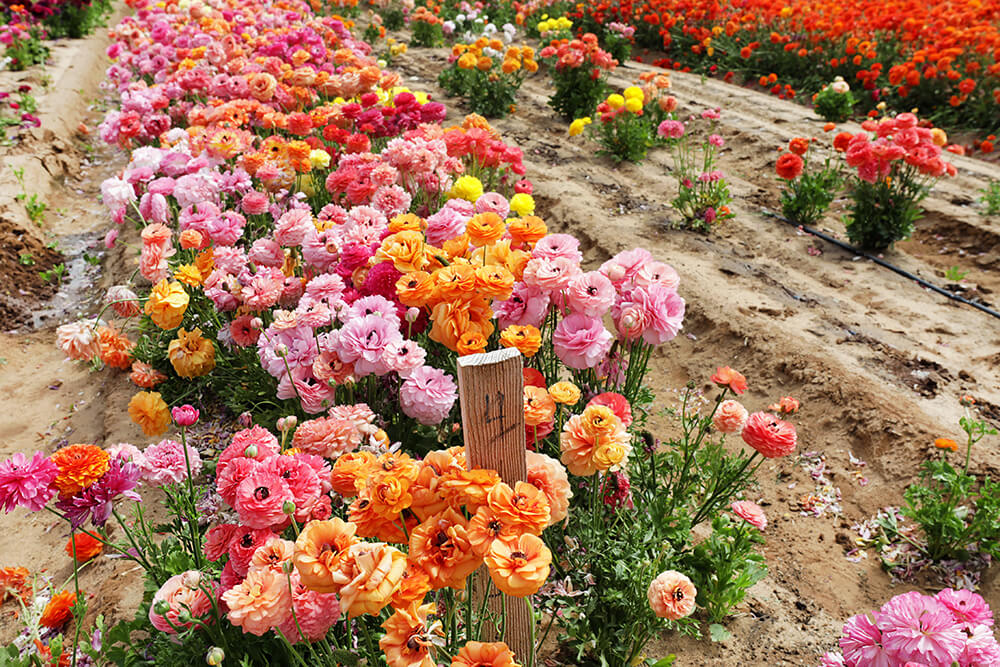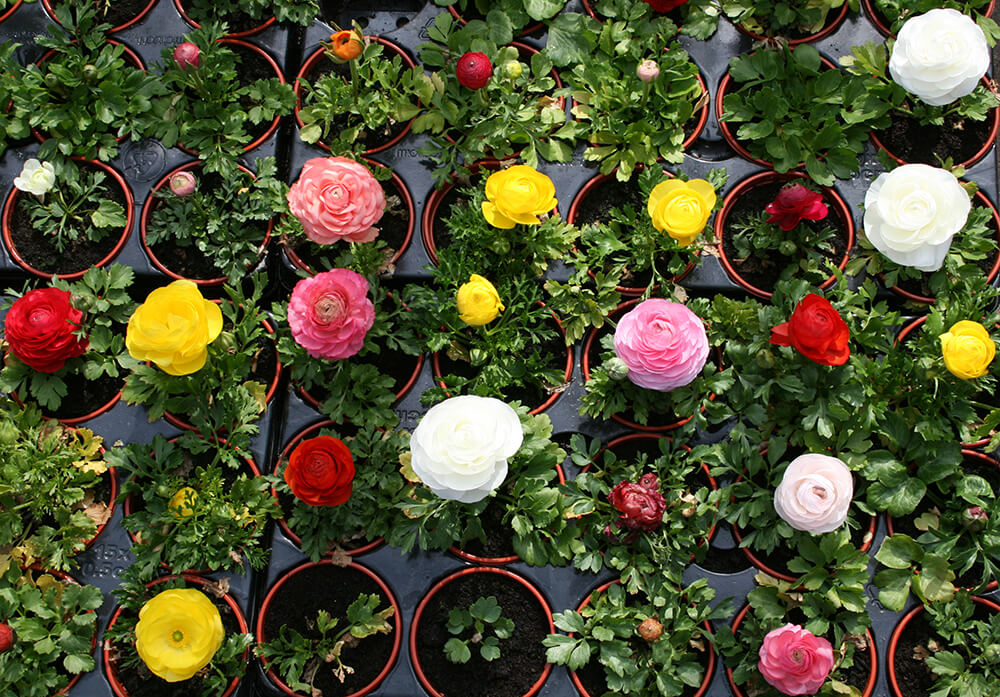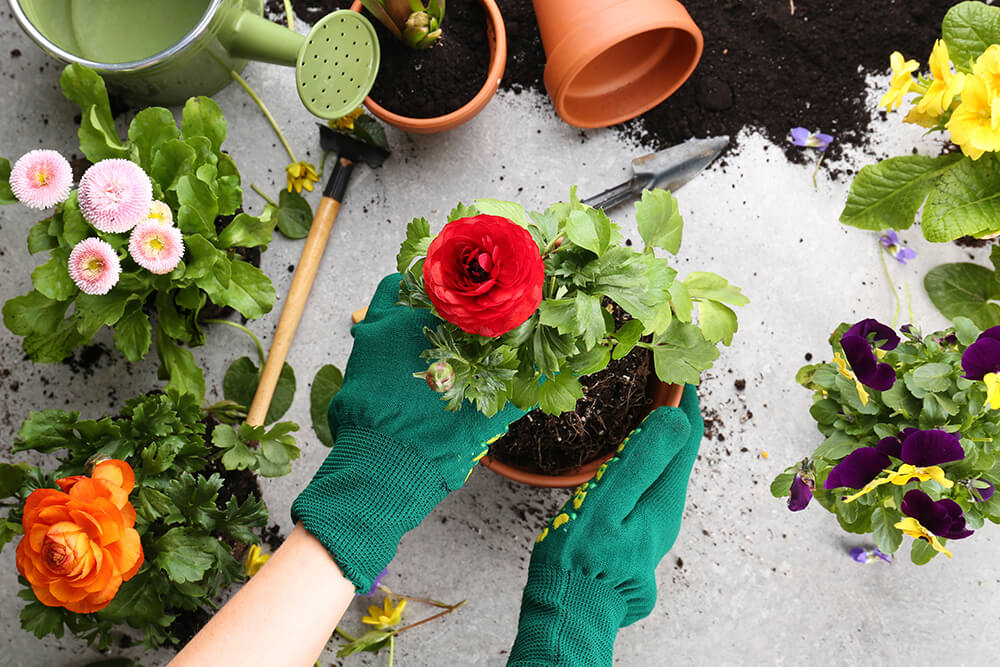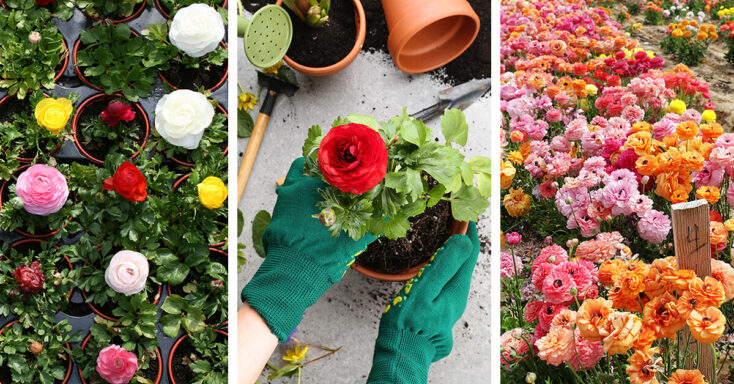Ranunculus is a genus of flowering plants. They are part of the family Ranunculaceae, commonly known as buttercups. Other plants in this family include larkspur, marsh marigold, clematis, and anemone. Buttercups dot the world with a wide range of colors, shapes, and sizes. Learn everything you need to know about the basics of ranunculus care, so you can make it bloom at home!
Ranunculus plants are herbaceous perennials, although some species can be annuals or biennials. They typically have tuberous or fibrous roots, and their foliage is basal, with leaves that can be deeply lobed or compound. While that sounds rather bland, in this article, you’ll learn more about the wonders of ranunculus and how to grow them successfully.
Key Takeaways
- Ranunculus are intricate, showy flowers, which make them popular choices for not only your garden but also floral arrangements.
- Unfortunately, Ranunculus are all toxic to pets and humans alike, so place them in your landscape accordingly.
- These plants have a rainbow of blossom options: Red, orange, yellow, purple, pink, and white.
- In order to blossom properly and abundantly, Ranunculus needs 6-8 hours of full to partial sun daily.
Center Stage
The flowers of Ranunculus are the principal attraction of these plants. They have cup-shaped blooms with multiple layers of petals (smooth or ruffled), usually varying in color from white and yellow to shades of pink, red, and orange. Overall, the flowers have a delicate and intricate appearance.
Ranunculus plants are popular in gardens and floral arrangements because of their vibrant and showy flowers. They have significant ornamental value and are popular choices for cut flowers, wedding bouquets, and flower beds.
Do you remember the delight of having a shiny yellow buttercup flower held under your chin? If your chin didn’t turn yellow, you don’t like butter!
Pleasing Petals: Ranunculus flowers showcase a remarkable diversity in petal formations. Some varieties have a single row of petals, while others have multiple layers, creating a layered, rose-like appearance. The petals grow tightly or more loosely depending on the cultivar.
Basic Ranunculus Care

There are three keynotes in Ranunculus care.
- Sunlight: Ranunculus plants require full sun to partial shade. They prefer at least 6 to 8 hours of direct sunlight each day, especially during the growing season. Adequate sunlight promotes robust growth and abundant flowering.
- Temperature: Ranunculus plants prefer cool to mild temperatures. They thrive in regions with daytime temperatures between 55-65°F (13-18°C). However, some varieties can tolerate slightly warmer temperatures, up to 75°F (24°C), if provided with adequate water and shade during hot spells. Ranunculus plants may not perform well in regions with extremely high temperatures.
- Soil: Well-drained soil is crucial for Ranunculus plants. They prefer fertile, loamy soil with good moisture retention capacity. Ensure that the soil is loose and well-aerated. You can achieve this by amending the soil with organic matter, such as compost or well-rotted manure, providing extra nutrients.
Ranunculus has a mythological connection to a prince in Asian folklore. According to the legend, there was a handsome prince who could not express his love to the nymphs he adored. His unrequited love haunted him so much that he eventually died. After his death, he transformed into the flower we now know as ranunculus, with its tissue-like petals that bear his name. This was his gift to the nymphs.
Other Ranunculus Needs
Besides sunlight, temperature, and soil specifics, here are some other needs you should handle when caring for your plant.
- Location: Choose a well-draining location with full sun or partial shade for Ranunculus. Ensure the soil is fertile, rich in organic matter, and has good drainage to prevent rotting. Avoid heavy clay soils. If need be, have a soil test done.
- Planting: Ranunculus grows from corms (bulb-like structures). Plant the corms in the fall, about 2 to 3 inches deep and 4 to 6 inches apart, with the pointed side facing downwards. Space rows about 8 to 12 inches apart.
- Watering: Keep the soil consistently moist but not waterlogged. Water deeply when the top inch of soil feels dry. Avoid over-watering, as it can cause corms to rot. Reduce watering as the foliage dies back after blooming.
- Mulching: Apply a layer of organic mulch, such as straw or shredded bark, around the plants to help retain moisture, regulate soil temperature, and suppress weeds. Take care not to cover the corms with mulch.
- Fertilization: Once growth begins, apply a balanced, water-soluble fertilizer every two to three weeks during the growing season, following the package instructions.
- Support and Staking: Provide support for taller varieties by inserting stakes or cages early in the season. This helps prevent plants from flopping over as they grow and produce heavy blooms.
- Deadheading: Remove spent flowers regularly to encourage continuous blooming. This also prevents the plants from wasting energy on seed production.
Remember to consult specific care instructions for the exact variety of Ranunculus you are growing, as some may have unique requirements. By providing the right conditions, proper care, and attention to detail, you can enjoy a bountiful display of Ranunculus blooms.
Symbolism and Meaning: In the Victorian era, people would send ranunculus flowers to those they admired, considering them charming and attractive. This makes them a splendid choice for special occasions like Mother’s Day, anniversaries, or simply to express your admiration for someone. Besides this, the language of flowers lists them as an expression of love and affection.
In spring, you may see these flowers as centerpieces in special celebrations, particularly weddings. Ranunculus welcomes the season with joy and cheer as a sign of renewal. For artists, poets, and painters, having this flower around enhances creativity and inspiration.
Buying Ranunculus for Your Garden

Ranunculus is a diverse flower genus that offers a wide range of stunning varieties. Here are some of the popular ones:
- Amandine Rose: This cultivar is a florist favorite, featuring rich pink petals with multiple ruffled layers. It thrives in cool spring weather and produces nearly three-inch flowers!
- Cloni Dark Orange: This series of Ranunculus features multiple layers of petals and giant flower heads. Cloni Dark Orange specifically offers vibrant, dark orange blooms. Stems are 10 inches tall.
- Cortusifolius: Originating from the Canary Islands, this variety produces large gold flowers resembling tropical hibiscus blooms. It is a spring-blooming plant that thrives in bright, shady areas. 2 feet tall foliage with up to an 8-inch spread.
- Fig buttercup is a low-growing plant with bright yellow flowers. It snuggles in meadows and woodland areas. 8 inches tall.
- Hanoi: This cultivar offers ethereal pink petals that resemble cotton candy and marshmallows. Something highly sought after, especially for wedding bouquets. Size: 2’ by 2’.
- lyallii: This species is native to New Zealand and features tall stems with large white blooms. It is one of the tallest varieties of Ranunculus. Height: 3 feet.
- Meadow buttercup: This species showcases bright yellow flowers with glossy petals. It is a perennial plant often found in grassy areas and meadows. 3×3
- Persian buttercup is the most common and widely cultivated species of Ranunculus. It comes in various vibrant colors, such as orange, pink, yellow, and red. 1-2 feet tall and wide.
- Tango: Exhibiting sultry layers of ruby-colored petals, this variety can rival red roses. Up to 20 blossoms per plant. It is comparatively easier to grow and does not require the use of pesticides.
- Vener: This variety showcases a captivating hue that lies between pink and coral. Its blossoms resemble a perfect sunset, bringing warmth and beauty to any space. Plant height: 10-40 inches.
The genus word Ranunculus is a Latin term. It roughly translates as “little frog.” The designation may have come about because these bulbs naturally flourish near bodies of water where frogs frolic.
Outdoor Ranunculus Watering Techniques
Your Ranunculus plants prefer consistently moist soil but not “wet.” Water deeply whenever the top inch of soil feels dry to the touch. Depending on the weather, they need watering every three days. Avoid overdoing it. This plant is susceptible to root rot when water pools around the roots.
Rainwater Use: If possible, collect and use rainwater to water your Ranunculus plants. Rainwater is free of chemicals and has a balanced pH, making it beneficial for these plants.
Apply a layer of organic mulch around the base of the Ranunculus plants to help retain soil moisture. Mulch also helps regulate soil temperature and suppresses weed growth.
Medicinal Uses for Ranunculus: Medicinal Uses: Ranunculus flowers have various medicinal purposes. Native Americans used the roots of the flower to treat skin ailments such as boils and warts. Ranunculus buttercup essential oils also have soothing properties used in traditional medicine to alleviate muscle tension, body aches, and sore joints.
Ranunculus: Outdoor Potting and Repotting
These flowers are ideal for container gardening. Select a container with good drainage to prevent water logging. Ensure it is wide enough to accommodate the ranunculus bulbs comfortably.
Ranunculus plants prefer well-draining soil. Use a mix of potting soil, sand, and perlite to ensure proper drainage. Avoid heavy soils that may cause water to stagnate around the roots.
Plant the ranunculus bulbs with the “claws” or tubers facing downward, about 2 inches deep into the soil. Space the bulbs a few inches apart to allow for proper growth and airflow.
Ranunculus plants require bright, indirect sunlight to thrive. Place the pots in areas of your landscape that receive at least 6 hours of sunlight each day. Re-potting is the same process without using the current soil of the parent plant. A fresh start provides nutrients. Get a crock about 1-2 inches bigger than the current one, and you’re ready to go.
While ranunculus flowers are visually stunning, unlike some lovely flowers, you can’t use these in the kitchen considered edible. In fact, ranunculus plants contain toxins, including protoanemonin, which have negative effects when ingested. These toxins cause a range of symptoms, such as stomach upset, nausea, vomiting, and diarrhea. Keep it away from your pets.
Pruning and Maintenance for Outdoor Ranunculus
You won’t be spending too much time keeping up with your Ranunculus. When you water, remove any spent flowers you see. When foliage becomes yellow, you can cut it down to about 1-2 inches above the soil. This allows the plant to conserve energy and encourages new growth.
You can prune in the fall after the first frost. By now, your plant is dying back, so remove all the plant’s top foliage. This helps recharge the bulb for the next season’s growth and bloom.
Ranunculus by Any Other Name: Ranunculus has several other names. Here are some alternative names for ranunculus:
- Buttercup: Ranunculus is a member of the buttercup family (Ranunculaceae), and the name “buttercup” is often used to refer to different species within the genus, including the popular garden variety.
- Persian Buttercup: This name specifically refers to the Ranunculus asiaticus species, which is widely cultivated for its vibrant and colorful flowers.
- Coyote’s Eyes: This name originated due to the appearance of ranunculus flowers due to their numerous bright petals that encircle a central cluster of tiny yellow or greenish-yellow flowers, resembling the eye of a coyote.
- Crowfoot: The name “crowfoot” is sometimes used to refer to ranunculus as its has divided leaves with narrow lobes reminiscent of the foot of a crow.
- Bachelor’s Button: This name appears with certain types of ranunculus because of their button-like shape and multiple layers of petals resembling a button.
- Turban Buttercup: This name particularly relates to the Ranunculus asiaticus ‘Tecolote’ cultivars, featuring distinctive cup-shaped flowers with vibrant colors and layered petals that resemble a turban or crown.
Garden Ranunculus Blooming and Resting Periods
Blooming period: Ranunculus plants’ blooming period typically occurs in the spring, starting in late winter or early spring, depending on the climate and region. The flowers can last for several weeks, providing a beautiful display in gardens or as cut flowers in bouquets.
After the blooming period, Ranunculus plants enter a resting or dormant phase. During this time, the foliage turns yellow and withers. The plant redirects its energy towards storing nutrients in its underground tubers for the next growing season. The resting period typically occurs in the summer or warmer months.
Ranunculus tubers enter a period of dormancy where they are in a state of rest and do not actively grow. It’s important to leave the tubers in the ground during this time, as they require a period of cool temperatures to facilitate the next blooming cycle.
As the weather cools down and the conditions become favorable, the Ranunculus tubers will naturally begin their regrowth phase. It begins in the late fall or early winter, depending on the climate. New shoots will emerge from the dormant tubers, leading to a new cycle of growth and, ultimately, another blooming period in the following spring.
Indoor Plants?
It is possible to grow ranunculus indoors. Although ranunculus plants usually remain in outdoor gardens, you can also cultivate them in pots or containers indoors. They make a colorful and sweet addition to indoor landscapes.

Common Pests & Plant Diseases
Yes, Ranunculus can be susceptible to certain pests and diseases. Here are some common issues and management strategies:
Aphids: These small insects feed on plant sap and can cause distorted growth and yellowing of leaves. Control aphids by spraying the affected plants with a strong jet of water to dislodge them. Alternatively, use insecticidal soap or neem oil as an organic control method.
Slugs and snails: These pests munch on leaves, causing irregular holes and damage. Use physical barriers such as copper tape or diatomaceous earth to deter them. Beer traps or slug pellets can also be effective for control.
Mites: Spider mites can cause yellowing leaves, stippling, and webbing. Spray affected plants with a strong jet of water to dislodge them. Use insecticidal soap or neem oil to control severe infestations.
Botrytis Blight: This fungal disease causes brown spots and rot on leaves, stems, and flowers. Avoid overhead watering and provide good air circulation to prevent moisture buildup. Remove and destroy infected plant material. Fungicides may be necessary for severe cases.
Archaeologists discover ranunculus fossilized seeds dating to the Pliocene Era (5 million years ago). The cultivated form of ranunculus arrived in Europe during the reign of Queen Elizabeth I in the 16th century. Its popularity as a garden flower grew quickly, and it has since become a beloved flower in Europe and around the world.
Troubleshooting Common Problems
- Lack of blooming: If your Ranunculus plants are not blooming, there could be several reasons. Insufficient sunlight may be a factor, as Ranunculus requires full sun for at least 6-8 hours daily. Ensure that the plants are receiving adequate light. Additionally, a lack of nutrients or imbalanced soil pH can affect blooming. Consider applying a balanced fertilizer specifically formulated for flowering plants.
- Poor flower quality: If the Ranunculus flowers are not of good quality, it may be because of environmental stress, inadequate water, or high temperatures. Ensure that the plants receive adequate water during the blooming period, keeping the soil consistently moist. Consider using mulch to keep moisture and regulate soil temperature. Protect the plants from extreme heat by providing shade during the hottest parts of the day.
- Yellowing foliage: Yellowing foliage during the resting period is normal as the plant prepares for dormancy. However, if the foliage turns yellow prematurely or excessively, the problem is overwatering, poor drainage, or fungal diseases. Ensure the soil has proper drainage and reduce watering during the resting period. Allow the soil to dry slightly between waterings.
- Rotting tubers: Excessive moisture during the resting period can lead to tuber rot. To prevent this, gradually reduce watering and allow the soil to dry out before the resting period. Ensure the soil has good drainage and amend it with organic matter to improve drainage. If you notice mushy tubers, inspect them for signs of rot and remove any affected ones to prevent a spread.
Summary
While Ranunculus is a sun lover, it doesn’t like it hot. The best temperature range for them is 45-65F. If these temperatures remain, you can grow this plant as an herbaceous perennial. If you live in a warmer region, you may have to grow these as annuals, container planted, so you can move them out of the heat when necessary. Remember to water deeply during the growing season, then slow the moisture intake after all the flowers expire.
Frequently Asked Questions About Ranunculus Plants Care and Keeping
How do you maintain ranunculus?
Ranunculus is like any other plant. It requires consistent moisture, but it's important not to overwater them. Prior to planting, amend the soil with organic matter to provide essential nutrients. During the growing season, you can fertilize the plants with a balanced, slow-release fertilizer according to the product instructions. This helps promote healthy growth and blooming.
Ranunculus plants thrive in full sun or partial shade. Ensure they receive at least 6-8 hours of direct sunlight per day for optimal growth and blooming. Watch for flowers dying off and pinch them away from the plant (deadheading). Be diligent. Watch for pests and diseases.
Can you overwater ranunculus?
Yes, overwatering can be detrimental to Ranunculus plants. While they require consistent moisture, excessive watering can lead to several problems. Too much water may pool around the roots, followed by the development of fungal diseases.
Do ranunculus multiply each year?
Yes, Ranunculus plants can multiply each year under the right conditions. They reproduce through their underground tubers, which can create new daughter tubers as the plant grows and matures. Each tuber can send up multiple stems or shoots, further increasing the number of blooms.
How long will ranunculus last?
Ranunculus plants are tender perennials in most climates, meaning they can survive and bloom for multiple years under favorable conditions. However, in colder climates, where temperatures drop significantly during winter, Ranunculus plants may not survive the cold. So, people grow them as annuals. With proper care and maintenance, Ranunculus plants can last up to 3-5 years or even longer.
What month are ranunculus in season?
Ranunculus plants flower from late winter to early spring. The exact timing of the blooming period can vary depending on the climate and geographical location. In warmer regions, such as southern parts of the United States, ranunculus flowers can start blooming as early as February or March. In cooler regions, they may bloom a bit later, like in April or May.
Final Thoughts
When I look at Ranunculus, it has this natural elegance. I could easily daydream for hours in a garden filled with them. In the spring, the ruffly petals open and share their sweet citrus scent on the winds. Bring a book! Join me.


